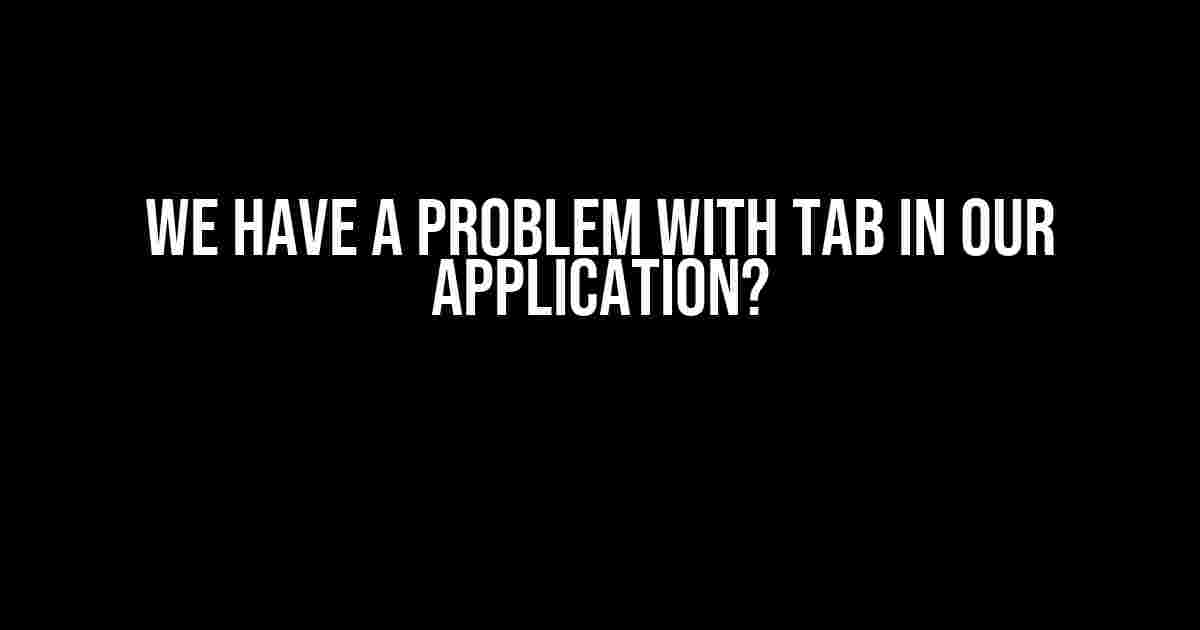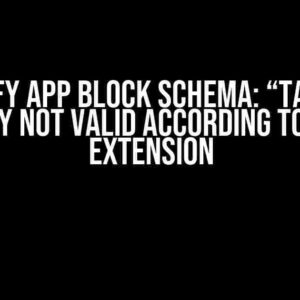If you’re reading this, chances are you’re frustrated with the pesky tab issue plaguing your application. Don’t worry, you’re not alone! In this article, we’ll dive into the common problems related to tabs, their causes, and most importantly, solutions to get your app back on track.
The Problem: A Brief Overview
A tab, a fundamental component of many user interfaces, seems simple enough. However, when things go awry, it can be a nightmare to debug. Some common issues with tabs include:
- Tabbed content not displaying correctly
- Tab navigation not working as expected
- Tab-related JavaScript errors
- Inconsistent tab styling across different browsers
Causes of the Problem
Before we dive into the solutions, it’s essential to understand the possible causes of the tab issue:
- Incorrect HTML structure: A poorly constructed HTML structure can lead to tab-related issues. Make sure to use the correct semantic elements and nesting.
- JavaScript conflicts: tabIndex, focus, and click events can conflict with other JavaScript libraries or custom code, causing tabs to malfunction.
- CSS styling issues: Inconsistent or overriding CSS styles can affect tab appearance and behavior.
- Browser compatibility: Different browsers can render tabs differently, leading to inconsistencies.
- Third-party library conflicts: Integrating third-party libraries or plugins can sometimes interfere with tab functionality.
Solutions to the Problem
Now that we’ve identified the possible causes, let’s explore the solutions:
1. Verify HTML Structure
First, ensure your HTML structure is correct and semantic:
<div class="tab-container">
<ul class="tabs">
<li><a href="#tab1">Tab 1</a></li>
<li><a href="#tab2">Tab 2</a></li>
</ul>
<div class="tab-content">
<div id="tab1">Tab 1 content</div>
<div id="tab2">Tab 2 content</div>
</div>
</div>
2. JavaScript Troubleshooting
Use the browser’s developer tools to identify any JavaScript errors or conflicts:
- Check the console for errors related to tabs
- Use the debugger to step through tab-related JavaScript code
- Verify that tabIndex is set correctly for each tab element
3. CSS Styling Fixes
Inspect the CSS styles applied to your tabs and make adjustments as needed:
| Property | Value | Description |
|---|---|---|
| display | inline-block | Ensure tabs are displayed inline |
| float | left | Float tabs to the left for a horizontal layout |
| margin | 10px | Apply margin to create space between tabs |
4. Browser Compatibility
To ensure cross-browser compatibility, use CSS resets or normalize styles:
<style>
/* CSS reset */
* {
box-sizing: border-box;
margin: 0;
padding: 0;
}
/* Normalize tab styles */
.tab {
display: inline-block;
margin: 10px;
padding: 10px;
border: none;
border-radius: 5px;
background-color: #f0f0f0;
cursor: pointer;
}
</style>
5. Third-Party Library Conflicts
If you’re using third-party libraries or plugins, try:
- NoConflict mode for JavaScript libraries
- Namespace or prefix styles to avoid conflicts
- Customize or override library styles to match your application’s design
Best Practices for Tab Implementation
To avoid future tab-related issues, follow these best practices:
- Use semantic HTML structure: Ensure your HTML is correct and consistent.
- Separate concerns with CSS and JavaScript: Keep styling and functionality separate to avoid conflicts.
- Test thoroughly across browsers and devices: Verify your application’s tab functionality on different browsers, devices, and screen sizes.
- Use a CSS preprocessor or framework: Utilize tools like Sass or Bootstrap to simplify styling and reduce conflicts.
- Keep JavaScript code organized and modular: Structure your JavaScript code to avoid conflicts and make debugging easier.
Conclusion
In conclusion, a tab issue in your application can be frustrating, but with a systematic approach to debugging and a solid understanding of the causes and solutions, you can resolve the problem efficiently. By following the best practices outlined in this article, you’ll be well-equipped to handle future tab-related challenges and create a better user experience for your application’s users.
Remember, a well-structured HTML, CSS, and JavaScript codebase, combined with thorough testing and a proactive approach to debugging, will help you overcome the tab issue and ensure a smooth user experience.
Frequently Asked Question
Having trouble with tabs in your application? Don’t worry, we’ve got you covered!
Why are tabs not showing up in my application?
Make sure you’ve enabled tabs in your application settings! Sometimes, a simple toggle can resolve the issue. If that doesn’t work, try clearing your browser cache and reloading the page.
How do I reorder tabs in my application?
Easy peasy! Simply click and hold on the tab you want to move, and then drag it to the desired position. You can also use the “Reorder” option in the tab settings menu.
Why are some tabs not loading properly in my application?
This might be due to a network connectivity issue or a problem with the specific tab’s content. Try reloading the tab or checking your internet connection. If the issue persists, reach out to our support team for further assistance!
Can I customize the appearance of tabs in my application?
Absolutely! You can change the tab color, font, and even add custom icons using our built-in customization options. Just head to the tab settings menu and get creative!
How do I delete a tab in my application?
Simple! Right-click on the tab you want to delete and select “Delete” from the context menu. Alternatively, you can also use the “Remove” option in the tab settings menu.



